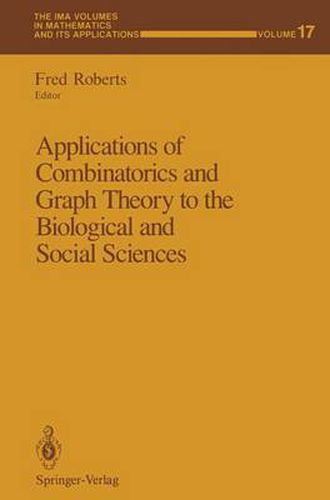Readings Newsletter
Become a Readings Member to make your shopping experience even easier.
Sign in or sign up for free!
You’re not far away from qualifying for FREE standard shipping within Australia
You’ve qualified for FREE standard shipping within Australia
The cart is loading…






This title is printed to order. This book may have been self-published. If so, we cannot guarantee the quality of the content. In the main most books will have gone through the editing process however some may not. We therefore suggest that you be aware of this before ordering this book. If in doubt check either the author or publisher’s details as we are unable to accept any returns unless they are faulty. Please contact us if you have any questions.
This IMA Volume in Mathematics and its Applications Applications of Combinatorics and Graph Theory to the Biological and Social Sciences is based on the proceedings of a workshop which was an integral part of the 1987-88 IMA program on APPLIED COMBINATORICS. We are grateful to the Scientific Committee: Victor Klee (Chairman), Daniel Kleitman, Dijen Ray-Chaudhuri and Dennis Stanton for planning and implementing an exciting and stimulating year long program. We especially thank the Workshop Organizers, Joel Cohen and Fred Roberts, for organizing a workshop which brought together many of the major figures in a variety of research fields connected with the application of combinatorial ideas to the social and biological sciences. A vner Friedman Willard Miller APPLICATIONS OF COMBINATORICS AND GRAPH THEORY TO THE BIOLOGICAL AND SOCIAL SCIENCES: SEVEN FUNDAMENTAL IDEAS FRED S. RoBERTS* Abstract. To set the stage for the other papers in this volume, seven fundamental concepts which arise in the applications of combinatorics and graph theory in the biological and social sciences are described. These ideas are: RNA chains as words in a 4 letter alphabet; interval graphs; competition graphs or niche overlap graphs; qualitative stability; balanced signed graphs; social welfare functions; and semiorders. For each idea, some basic results are presented, some recent results are given, and some open problems are mentioned.
$9.00 standard shipping within Australia
FREE standard shipping within Australia for orders over $100.00
Express & International shipping calculated at checkout
This title is printed to order. This book may have been self-published. If so, we cannot guarantee the quality of the content. In the main most books will have gone through the editing process however some may not. We therefore suggest that you be aware of this before ordering this book. If in doubt check either the author or publisher’s details as we are unable to accept any returns unless they are faulty. Please contact us if you have any questions.
This IMA Volume in Mathematics and its Applications Applications of Combinatorics and Graph Theory to the Biological and Social Sciences is based on the proceedings of a workshop which was an integral part of the 1987-88 IMA program on APPLIED COMBINATORICS. We are grateful to the Scientific Committee: Victor Klee (Chairman), Daniel Kleitman, Dijen Ray-Chaudhuri and Dennis Stanton for planning and implementing an exciting and stimulating year long program. We especially thank the Workshop Organizers, Joel Cohen and Fred Roberts, for organizing a workshop which brought together many of the major figures in a variety of research fields connected with the application of combinatorial ideas to the social and biological sciences. A vner Friedman Willard Miller APPLICATIONS OF COMBINATORICS AND GRAPH THEORY TO THE BIOLOGICAL AND SOCIAL SCIENCES: SEVEN FUNDAMENTAL IDEAS FRED S. RoBERTS* Abstract. To set the stage for the other papers in this volume, seven fundamental concepts which arise in the applications of combinatorics and graph theory in the biological and social sciences are described. These ideas are: RNA chains as words in a 4 letter alphabet; interval graphs; competition graphs or niche overlap graphs; qualitative stability; balanced signed graphs; social welfare functions; and semiorders. For each idea, some basic results are presented, some recent results are given, and some open problems are mentioned.